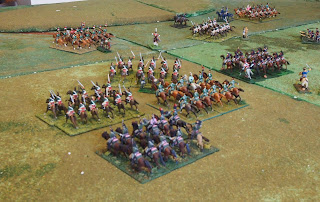Little Boy: What's that over there Dad?
Dad: That's Lancashire.
Little Boy: What's Lancashire?
Dad: Shite!
Meanwhile, in antipodean York, the brave York roo-boys gathered before the little village of Needling Hills (aka St Albans) in which the evil redback tossers from West Dale (aka Lancastrians) were ensconced. They held King Henry VI, recently recovered(?) from madness, whom they had tricked and cajoled to expel the brave and wise Duke of York in favour of the sly Somerset; aka 'the loser of France'.
Not wishing to spill the blood of countrymen, Somerset was summoned to parley. He was made a simple, but generous offer:
Oi, Somerset!
Give us back our king, resign your post as high chancellor and bugger off.He replied in the negative.
The Duke of York advanced the right, Salisbury the left, while Warwick held in the centre.
The Yorkist archers took down some of the Lancastrians, who were cowering behind carts and a tumble-down fence.
In preparation for the assault, the men at arms and billmen moved to the front; Warwick's men now also advanced.
Salisbury's (foreground) and the Duke of York's (distance) men attacked the defences held by Clifford and Somerset respectively.
Salisbury's men pushed back Clifford's smaller force (which he had foolishly extended into a single line), but York's men failed in their attack and were themselves pushed back. They gathered for a renewed attack, as Warwick's 'battle' prepared to attack the centre, held by Buckingham.
Salisbury's men pressed their advantage, crossing the ditch and entering the town to rejoin mêlée with Clifford's hard-pressed defenders. York's and Warwick's came to grips with the Lancastrians.
Clifford's 'battle' broke and were pursued by Salisbury's victorious men-at-arms and billmen. "Drive on and secure the King", Salisbury yelled.
They captured Clifford!
Buckingham's and Somerset's troops also began to give ground...
... then, Buckingham was killed, his men fled. Somerset's troops broke too.
A glorious Yorkist victory!
The York (roo) boys broke into song:
Hearts to hearts and hands to hands,
Beneath the rose so white we stand,
We shout, God bless our native land,
Old York. Old York.
Out we come, out we come, out we come to play,
Just for recreation’s sake, to pass the time away,
Lots of fun, heaps of fun, enjoy yourself today,
The York roo boys are hard to beat when they come out to play.
So join in the chorus, and sing it one and all,
Join in the chorus, the Yorkists' on the ball,
Good old Yorkists, they're champions you'll agree,
The White Rose is the team that plays to win for you and me.
Appendix
Thanks to Mark for putting on the game, which he based on an article in a 2010 Miniature Wargames and for umpiring (although, I am beginning to fear that he was dropped on his head as a baby, with his Lancastrian tendencies an' all!!).
Thanks to Julian for 'putting up a bit of a show' and being so good, as ever, about his appalling luck with the dice. In all of the mêlées either I got the random bonus, or the roll was drawn, so that neither side got one!
We used a 'new' set of rules that Mark had brought out from his shelves for a test run earlier in the year. That game, a re-fight of the Battle of Hexham, has not been reported on this blog yet but was, I am pleased to say, another great Yorkist victory!
# Another Derby
This miniature Derby was held a week prior to another first Derby for 2018 that will be played next week, 'down the hill'. That one will feature the Dockers vs the Eagles. It is difficult to think of better symbols for perfidious Albion and Napoleonic France!





















































